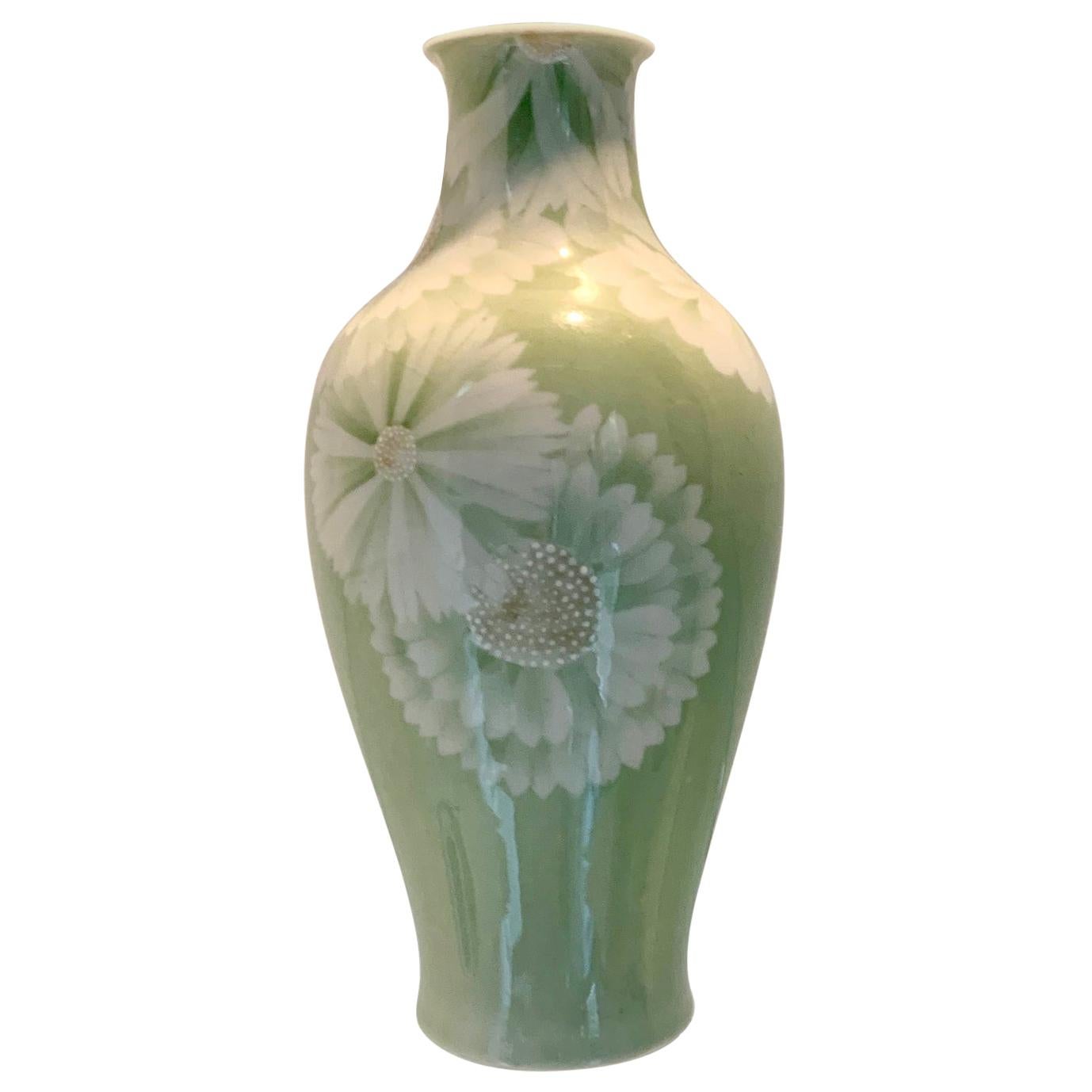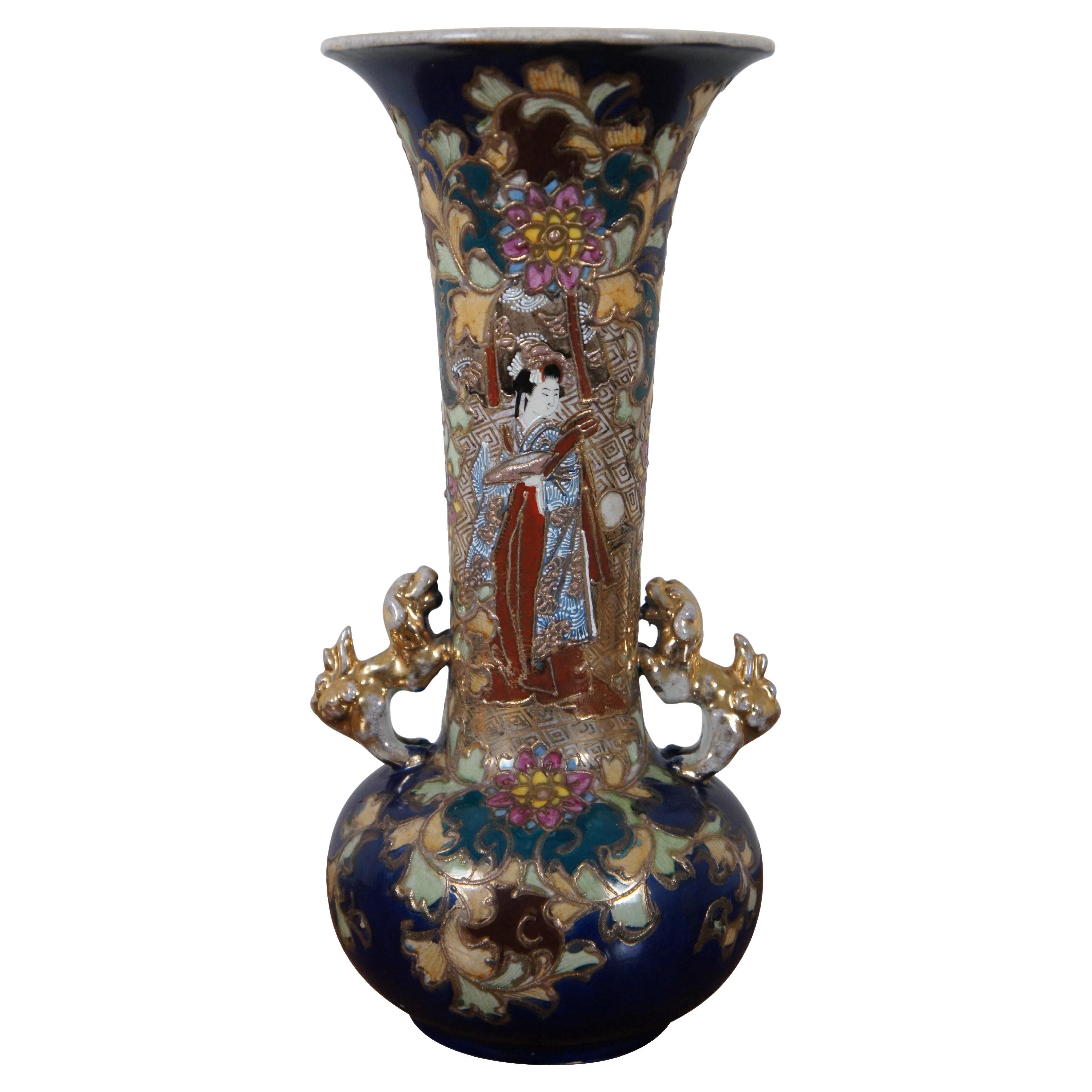Items Similar to Antique Japanese Porcelain Figural Owl Wall Pocket Vase Meiji Period
Want more images or videos?
Request additional images or videos from the seller
1 of 14
Antique Japanese Porcelain Figural Owl Wall Pocket Vase Meiji Period
About the Item
We are offering a beautiful Japanese porcelain figural owl wall pocket vase dating from the Meiji Period. Great details and form. This would have mounted onto a wall. Marked on the back "Made in Japan" and has the makers mark. In very nice original condition. No cracks, no repairs, no broken parts and the color is great. Small glaze skip on the back and is original to the piece when made. Measures approx. 7" tall by 3 1/2" wide by 3 1/8" deep.
- Dimensions:Height: 7 in (17.78 cm)Width: 3.5 in (8.89 cm)Depth: 3.25 in (8.26 cm)
- Materials and Techniques:
- Place of Origin:
- Period:
- Date of Manufacture:1900s
- Condition:
- Seller Location:San Diego, CA
- Reference Number:1stDibs: LU887820599232
About the Seller
4.9
Vetted Seller
These experienced sellers undergo a comprehensive evaluation by our team of in-house experts.
Established in 2007
1stDibs seller since 2010
299 sales on 1stDibs
Typical response time: 1 hour
- ShippingRetrieving quote...Ships From: San Diego, CA
- Return PolicyThis item cannot be returned.
More From This SellerView All
- Antique Japanese Celadon Imari Nabeshima Enamel Porcelain Plate Meiji Era SignedLocated in San Diego, CAExquisite antique Japanese celadon porcelain "Nabeshima" enameled plate dating from the Meiji era. The plate is signed on the back by the artist. Great gold gilt hand painted accents...Category
Antique Late 19th Century Japanese Ceramics
MaterialsPorcelain
- Antique Chinese Lidded Floor VaseLocated in San Diego, CALarge Chinese porcelain enamel painted lidded floor vase with mythic phoenix birds and chrysanthemum floral decoration. Figural lion dog top han...Category
20th Century Chinese Chinese Export Ceramics
- Art Deco Lion Cubist Figural Porcelain Toothpick Holder Vase Figurine by NipponLocated in San Diego, CASuperb Art Deco/cubist lion figural toothpick holder figurine. Dates from the 1930s and made of porcelain. Made in Japan by Nippon and marked on the b...Category
Early 20th Century Vases
MaterialsPorcelain
- Antique Art Deco Nude Dancer Ballerina Figural Fan Shaped Greek Key Metal VaseLocated in San Diego, CAGreat antique Art Deco fan shaped figural white metal vase. Great design and detail. Greek key design on the bottom edge. Made in Japan and is marked on the bottom. In very nice orig...Category
Early 20th Century Vases
MaterialsMetal
- 1950s Modernist KPM Porcelain Berlin Abstract Art Vase, GermanyBy KPM PorcelainLocated in San Diego, CAWonderful KPM porcelain Berlin modernist abstract vase and dates from the 1950s. Signed on the bottom. Wonderful design and form. Made in Germa...Category
Mid-20th Century German Vases
MaterialsPorcelain
- 1960s Japanese Modernist Ikebana Ceramic Pottery Sgraffito Pedestal Vase VesselBy David CresseyLocated in San Diego, CAOutstanding Japanese modernist Ikebana ceramic/pottery pedestal vase/vessel, circa 1960s. Wonderful form and design. Has a sgraffito design around th...Category
Mid-20th Century Japanese Vases
MaterialsPottery
You May Also Like
- Japanese Porcelain Vase Makuzu Kozan Meiji PeriodBy Makuzu KozanLocated in Atlanta, GAA striking blue and white vase from the studio of Japanese Potter Makuzu Kozan, also known as Miyagawa Kozan (1842–1916), one of the most established and collected ceramist from Meiji Period. Born as Miyagawa Toranosuke, Kozan established his pottery studio in Yokohama circa 1870s and later became one of the appointed artists to the Japanese Imperial household. His work was exhibited in many international fairs that the Meiji government participated at the turn of the century and won many grand prizes. Of a relatively large size, this vase is decorated with underglaze cobalt blue using the novel technique developed by Kozan called Fuki-e (the blow painting). As a result, the bamboos appear took on a three-dimensional quality as if appearing in a mist. Known as one of the most creative ceramists, circa 1887, Kozan started experimenting with new chemical colors from the West in the format of his porcelain glaze. New colors allowed him to create underglaze design that appeared bright, smooth and glossy. He even invented his own receipt of cobalt blue to achieve a much brighter yet softer shade, as evident on this vase. To create landscape that is realistic and dimensional, more common in the western paintings, he was inspired by the native Japanese ink painting technique developed around 1900 by Yokoyama Taikan...Category
Antique Early 1900s Japanese Japonisme Ceramics
MaterialsCeramic
- Japanese Porcelain Vase Meiji Period Makuzu KozanBy Makuzu KozanLocated in Atlanta, GAA finely decorated and glazed Japanese porcelain vase by Makuzu Kozan (1842-1916) circa 1900s Meiji Period. The vase is of a classic bottle form with baluster body and short neck. It was decorated with underglaze white magnolia blossom on a pleasant celadon background. The stamens of the flower were artistically rendered in a low relief, giving the design a realistic appeal with the dimension. Miyagawa Kozan...Category
Early 20th Century Japanese Meiji Ceramics
MaterialsPorcelain
- Antique Meiji Period Kutani Japanese Porcelain Temple JarLocated in Lambertville, NJAntique Meiji period Japanese porcelain temple jar with intricate hand painted decoration and gilt. The jar in Classic Kutani colors with floral and phoenix birds all over the top an...Category
Antique 1880s Japanese Meiji Ceramics
MaterialsPorcelain
- Rare Antique Meiji Period Japanese Meiji Period Porcelain VaseLocated in Media, PARare Antique Meiji Period Japanese Meiji Period Porcelain Vase. This is a fabulous antique Japanese Meiji Period porcelain vase. This type of porcelain vase is imitating mix metal,...Category
Antique 19th Century Japanese Ceramics
MaterialsPorcelain
- Antique Japanese Meiji Era Porcelain Satsuma Figural Kutani Vase Fu Dogs GeishaLocated in Dayton, OH"Late Meiji era Kutani vase, circa 1903. A beautiful porcelain blue ground centered by an intricate Geisha flanked by gold figural Foo Dog handles. Features a floral and foliat motif throughout. Signed along the base. Kutani ware, Japanese porcelain made in Kaga province (now in Ishikawa prefecture). The name “Old Kutani” refers to porcelain decorated with heavily applied overglaze enamels and produced in the Kaga mountain village of Kutani. The powerful Maeda family had established a kiln there by 1656. The clay bodies used were gray and coarse-grained. On most pieces—dishes and bowls were especially common—a white or blue-white matte glaze was decorated in dark, restrained colours, initially greens, yellows, and some reds, and later purples and dark blues. Some items had cobalt blue decoration under a white glaze. The most noted Old Kutani pieces are “Green Kutani,” in which most of the surface is covered in a green or blue-green glaze to which one or two colours have been added (or the glaze is applied evenly over a design executed in black). The bold designs of Kutani ware drew freely from Chinese ceramics, paintings, and textiles. They are renowned for their rich pictorial ornament executed in lively, intense lines. Owing to local financial problems and difficulties in obtaining the necessary pigments, the Kutani kiln was abandoned some time in the Genroku period (1688–1704). Ceramics production in Kaga enjoyed a renaissance early in the 19th century, however, including the establishment of another kiln at Kutani in the 1820s. In addition to a revival of the styles of Old Kutani ware, there arose a style using gold on a coral-red ground, which was perfected during another spate of activity that began in the 1860s. Technical advances were made and Western-style pigments were adopted, and by the 1890s modern Kutani...Category
Antique Early 1900s Meiji Vases
MaterialsPorcelain
- Japanese Mishima Ceramic Vase Meiji PeriodLocated in Atlanta, GAA Japanese long neck slender ceramic vase in the style of Mishima, circa 19th century, Meiji period. Mishima pottery was originally imported from three islands in Taiwan and then fro...Category
Antique 19th Century Japanese Japonisme Ceramics
MaterialsCeramic
Recently Viewed
View AllMore Ways To Browse
Japanese Porcelain
Japanes Porcelain
Porcelain Figural
Made In Japan Ceramics
Japanese Furniture Maker
Japanese Furniture Makers
Antique Japanese Marks
Japanese Antique Marks
Japanese Porcelain Antiques
Antique Japan Porcelain
Asian Wall Antique
Antique Owl
Owl Antique
Antique Owls
Antique Asian Wall Art
Early Japanese Porcelain
Antique Ceramics Figure
Small Japanese Ceramics





